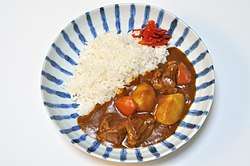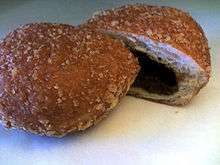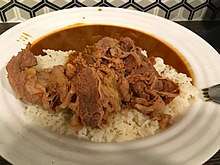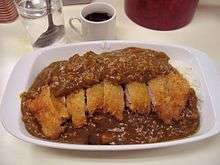Japanese curry
Japanese curry (カレー, karē) is commonly served in three main forms: curry rice (カレーライス, karē raisu, curry over rice), curry udon (curry over noodles), and curry bread (a curry-filled pastry). It is one of the most popular dishes in Japan.[1] The very common "curry rice" is most often referred to simply as "curry" (カレー, karē).
 A plate of Japanese style curry with rice | |
| Type | Curry |
|---|---|
| Place of origin | Japan |
| Main ingredients | Vegetables (onions, carrots, potatoes), meat (beef, pork, chicken) |
| Variations | Karē raisu, karē udon, karē-pan |
Along with the sauce, a wide variety of vegetables and meats are used to make Japanese curry. The basic vegetables are onions, carrots, and potatoes. Beef, pork, and chicken are the most popular meat choices. Katsu-karē is a breaded deep-fried cutlet (tonkatsu; usually pork or chicken) with Japanese curry sauce.[2]
Overview
Curry originates in Indian cuisine and was brought to Japan from India by the British. The Imperial Japanese Navy adopted curry to prevent beriberi, and now the Japan Maritime Self-Defense Force's Friday menu is curry.[3] The dish became popular and available for purchase at supermarkets and restaurants in the late 1960s. It has been adapted since its introduction to Japan, and is so widely consumed that it can be called a national dish.[1]
History
Curry was introduced to Japan during the Meiji era (1868–1912), at the time when the Indian subcontinent was under colonial rule by the British Empire.[4] By the 1870s, curry began to be served in Japan, and became a staple within the Japanese diet.[5] It wasn't until the early twentieth century, when curry was adopted by the Japanese Navy and Army, that the dish began to become popular with the Japanese.[6] After its favorable reception within the Japanese Army and Navy, it later became common in school cafeterias.[7] By 2000, curry was a more frequent meal than sushi or tempura.[7]
Curry similar to that served in the Indian sub-continent is known as Nakamuraya Curry. It was introduced to Japan by Rash Behari Bose when he began to sell curry at Nakamura Bakery in Tokyo.[8]
Sauce mixes
Curry sauce (カレーソース, karē sōsu) is served on top of cooked rice to make curry rice.[9] Curry sauce is made by frying together curry powder, flour, and oil, along with other ingredients, to make roux; the roux is then added to stewed meat and vegetables, and then simmered until thickened.[10] A pressure cooking can be used as well.[9] Adding potatoes to curry sauce was introduced by William S. Clark of the Sapporo Agricultural College, due to rice shortages at the time.[11]
In Japanese homes, curry sauce is most commonly made from instant curry roux, which is available in block and powder forms, and contains curry powder, flour, oils and various flavorings. Ease of preparation, and the wide variety and availability of instant curry mixes, has made curry rice very popular, as it is very easy to make compared to many other Japanese dishes. Pre-made curry is available in vacuum-sealed bags that can be reheated in boiling water. For those who still make their curry roux from scratch, there are also curry powders specially formulated to create the "Japanese curry" taste.[12]
Instant curry roux was first sold in powder form by House Foods in 1926, and in block form by S&B Foods in 1956. In 2007, Japanese domestic shipments of instant curry roux was 82.7 billion yen.[13] Market share for household use in 2007 was captured almost entirely by House Foods (59.0%), S&B Foods (25.8%) and Ezaki Glico (9.4%).[14][15] Curry is marketed to children utilizing characters from video games and anime.[16]
Vacuum-sealed curry sauce, prepared by heating the retort pouch in hot water or the microwave, is also popular. As of 2007, curry sauce is the largest single category of vacuum-sealed foods in Japan, making up over 30% of sales.[13]
Side dishes and garnishes
Curry rice is usually served with fukujinzuke or rakkyō on the side.[17]
Other varieties



- katsu karē (カツカレー): Curry rice served with a breaded pork cutlet on top.
- dorai karē (ドライカレー): Curry-flavored fried rice, or curry rice with a drier, mince meat curry sauce.
- maze karē (混ぜカレー): Curry rice, served with the sauce and rice already mixed. Popularized by the Jiyūken (自由軒) curry restaurants in Osaka.
- karē don (カレー丼): Curry sauce, thickened and flavored with mentsuyu or hondashi and served on top of a bowl of rice, to give the curry a Japanese flavor.
- aigake (合がけ): Rice served with curry sauce and hayashi sauce (fried beef and onion, cooked with red wine and demi-glace).
- yaki karē (焼きカレー): Curry rice, topped with a raw egg and baked in an oven. Originally from Kitakyushu.
- ishiyaki karē (石焼きカレー): Curry sauce with rice served in a heated stone bowl, in a similar way to dolsot bibimbap.
- sūpu karē (スープカレー): Soup curry, a watery, broth-like curry sauce served with chunky ingredients such as a chicken leg and coarsely-cut vegetables. Popular in Hokkaido.
Local curries
In the late 1990s, a number of regional specialty curries emerged, popularised as vacuum-sealed curry sauces. These include:
- Hokkaido Sika Deer curry (えぞ鹿カレー, ezoshika karē) from Hokkaido.
- Scallop curry (ほたてカレー, hotate karē) from Aomori Prefecture.
- Mackerel curry (サバカレー, saba karē) from Chiba Prefecture.
- Apple curry (リンゴカレー, ringo karē) from Nagano Prefecture and Aomori Prefecture.
- Nattō curry (納豆カレー, nattō karē) from Mito, Ibaraki.
- Nagoya Kōchin Chicken curry (名古屋コーチンチキンカレー, Nagoya kōchin chikin karē) from Aichi Prefecture.
- Matsusaka beef curry (松阪牛カレー, Matsusaka gyū karē) from Mie Prefecture.
- Whale curry (クジラカレー, kujira karē) from Wakayama Prefecture.
- Oyster curry (牡蠣カレー, kaki karē) from Hiroshima Prefecture.
- Nashi pear curry (梨カレー, nashi karē) from Shimane Prefecture.
- Black pork curry (黒豚カレー, kurobuta karē) from Kagoshima Prefecture.
- Bitter melon curry (ゴーヤーカレー, gōyā karē) from Okinawa.
Local curries are also marketed to help boost tourism. Some varieties of this include Yokosuka navy curry (よこすか海軍カレー, Yokosuka kaigun karē), sold in Yokosuka to promote its heritage as a naval base,[18] and Zeppelin Curry (ツェッペリンカレー, Tsepperin Karē) in Tsuchiura to promote the Zeppelin landing in 1929.[19]
Outside Japan
South Korea
Curry was introduced to South Korea during the period of Japanese rule, and is popular there. It is often found at bunsik restaurants (diner-style establishments), donkkaseu-oriented restaurants, and at the majority of Japanese restaurants. Premade curry and powdered mixes are also readily available at supermarkets.
North Korea
Japanese-style curry was introduced to North Korea by Koreans and Japanese who were abducted from Japan to North Korea during the 1960s-1970s repatriation project.[20] Along with other Japanese cuisine, it was traded by new arrivals for local products and used to bribe Worker's Party cadres.[20]
Elsewhere
Mixes can be found outside Japan and Korea in supermarkets that have a Japanese section or in Japanese or Asian food stores. Mixes are also available from retailers online.[21][22]
The largest Japanese curry company in Japan is House Foods Corporation. The company operated more than 10 Curry House Restaurants in the USA, until mid-2019 when it sold off its interest to a US company CH Acquisitions LLC, which abruptly closed the restaurants in February of 2020.[23] House Foods associated company CoCo Ichibanya (Ichibanya Co., Ltd.) or Kokoichi has more than 1,200 restaurants in Japan. CoCo Ichibanya has branches in China, Hong Kong, Taiwan, Korea, Singapore, Indonesia, Philippines, Thailand, Hawaii and California.[24]
Serving
Japanese curry rice is served in anything from a flat plate to a soup bowl. The curry is poured over rice in any manner and amount. Japanese short-grain rice, which is sticky and round, is preferred, rather than the medium-grain variety used in Indian dishes. It is usually eaten with a spoon, as opposed to chopsticks, because of the liquid nature of the curry, and is usually served garnished with vegetables pickled in vinegar such as fukujinzuke or rakkyo.
In Popular Culture
- In Isekai Shokudo, curry is one of the signature specialties of Nekoya, the titular restaurant and the favourite food of Alphonse Flugel.
- In Megaman NT Warrior, curry is the favourite food of Lan Hikari. He once spent three days eating eighty eight different kinds of curry while touring. Yahoot, one of the members of WWW is the owner of a famous curry restaurant run by his family for generations. He opted to resign from crime to start a small yet successful curry shop, Dex and Dingo would later became Yahoot's apprentice working in his shop learning to cook curry.
- In the Naruto anime, an eccentric curry chef named Sansho made a ridiculously spicy curry which is Rock Lee's favourite.
- In the One Piece series, Curry is commonly served in Marines's Kitchen, the protagonist Luffy once infiltrated a Marine base and ate enormous amount of curry which he enjoyed. It is also Brook's favourite food.
- In Persona 5, Sojiro Sakura invented a homemade curry recipe which he served to customers in his Cafe Leblanc. Sojiro's homemade curry is Futaba Sakura's favourite food, Sojiro would later teach the protagonist how to cook Leblanc's special curry.
See also
References
- 『カレーライス』に関するアンケート (in Japanese). ネットリサーチ ディムスドライブ. Retrieved 2016-02-01.
- "Chicken katsu curry". Food recipes. BBC. 2016. Retrieved 20 January 2016.
- Curry Recipe Japan Maritime Self-Defense Force (in Japanese)
- Itoh, Makiko (26 August 2011). "Curry — it's more 'Japanese' than you think". The Japan Times. Archived from the original on 8 January 2018. Retrieved 31 March 2018.
- Bell, Markus (8 April 2016). "From India To North Korea, Via Japan: Curry's Global Journey". The Salt. National Public Radio. Retrieved 15 November 2018.
- Tadashi Ono; Harris Salat (2013). Japanese Soul Cooking: Ramen, Tonkatsu, Tempura, and More from the Streets and Kitchens of Tokyo and Beyond. Ten Speed Press. p. 44. ISBN 978-1-60774-352-1.
- Makalintal, Bettina (2 November 2018). "A Brief History of How Curry Ended Up in Japan". Munchies. Vice. Retrieved 15 November 2018.
- Karmakar, Kaylan (25 September 2018). "Japanese Curry Is Nothing Like Indian Curry. Think Twice When In Japan". NDTV. New Delhi. Retrieved 17 November 2018.
- "Easy Instant Pot Japanese Bone-in Chicken Curry". Asian Cooking Mom. 25 April 2020. Retrieved 26 April 2020.
- Nancy Singleton Hachisu (4 September 2012). Japanese Farm Food. Andrews McMeel Publishing. pp. 289–290. ISBN 978-1-4494-1830-4.
- Colburn Goto, Gina (21 November 2014). "Curry is king". Japan Today. Tokyo. Retrieved 13 February 2019.
- Itoh, Makiko (26 August 2011). "Curry — it's more 'Japanese' than you think". The Japan Times. Tokyo. Retrieved 13 February 2019.
- 生産量の推移 [Transition of Production] (in Japanese). All Japan Curry Manufacturers Association. Retrieved March 7, 2011.
- ハウス食品 [Hause Foods] (PDF) (in Japanese). Keio University Marketing Research Study Group. Retrieved March 7, 2011.
- コンサルティングレポート 江崎グリコ株式会社 [Proposal for Ezaki Glico] (PDF) (in Japanese). Kutsuna Seminar at Faculty of Business Administration in Kobe University. Archived from the original (PDF) on July 22, 2011. Retrieved March 7, 2011.
- Chris Kohler (10 October 2016). Power-Up: How Japanese Video Games Gave the World an Extra Life. Courier Dover Publications. p. 188. ISBN 978-0-486-81642-5.
- Jan Davison (15 May 2018). Pickles: A Global History. Reaktion Books. p. 33. ISBN 978-1-78023-959-0.
- Trautlein, Steve, "The chow-down tour of Kanto's local dishes", The Japan Times, 24 August 2012, p. 15
- Hongo, Jun (14 November 2013). "Tsuchiura city curries favor with visitors at its annual gourmet festival". Japan Times. Retrieved 30 November 2018.
- Bell, Markus (2016-04-08). "From India To North Korea, Via Japan: Curry's Global Journey". The Salt. NPR. Retrieved 2016-05-12.
- "S&B Golden Curry Sauce Mix, Medium Hot, 7.8-Ounce". Amazon. Retrieved 26 April 2020.
- "S&B Golden Curry Sauce Mix Medium Hot, 3.5 OZ". Walmart. Retrieved 26 April 2020.
- https://web.archive.org/save/https://www.newsweek.com/curry-house-japanese-curry-spaghetti-closed-mystery-1488923
Further reading
- Eston, Elizabeth (2019). "The Footprints of the Indian Revolution in Japanese Food Culture". Rash Behari Bose: The Father of the Indian National Army, Vol 1. Tenraidou.
External links
| Wikimedia Commons has media related to Japanese Curry. |
- All Japan Curry Manufacturers Association (1 March 2019). "the world of JAPANESE CURRY". foodies go local. All Japan Curry Manufacturers Association.
- Ewbank, Anne (25 October 2018). "How Curry Became a Japanese Naval Tradition". Gastro Obscura. Atlas Obscura.